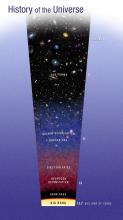Listen to today's episode of StarDate on the web the same day it airs in high-quality streaming audio without any extra ads or announcements. Choose a $8 one-month pass, or listen every day for a year for just $30.
You are here
Neutrinos
If you eat a bowl of chocolate ice cream, you can be pretty sure it won’t change to vanilla before you finish it. That’s not the case with the particles known as neutrinos. They come in three “flavors.” And they can change flavor as they zip through the universe — a trait that gave astronomers headaches.
Neutrinos are the second-most-common particles in the universe, after the ones that make up light. Many were created in the Big Bang. Others are forged in the hearts of stars, in the decay of radioactive elements, or inside nuclear reactors. Yet neutrinos almost never interact with other forms of matter. That makes them almost impossible to study.
Almost impossible, but not quite. Neutrino detectors do catch a few of the ghostly particles. And some of the early detections created a mystery.
The reactions in the Sun’s core produce enormous numbers of neutrinos. Yet early detectors found only a third as many as theory had predicted. That created some worry that perhaps the ideas about how stars work were off.
But early detectors were sensitive to only one type of neutrino — the kind produced by the Sun. The discovery that there are three types — three “flavors” — seemed to solve the problem: Most of the Sun’s neutrinos were transforming themselves on the way to Earth. Later instruments, which were sensitive to all three flavors, counted the right number of neutrinos — showing that the Sun is working just as it should.
More tomorrow.
Script by Damond Benningfield



